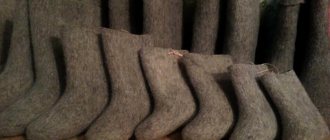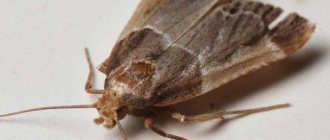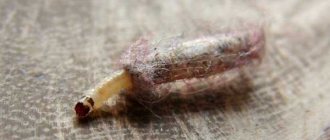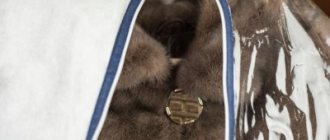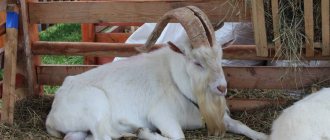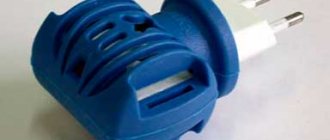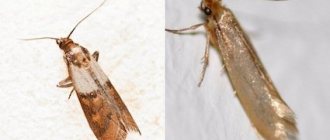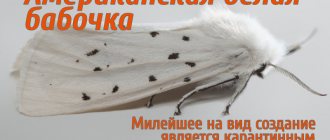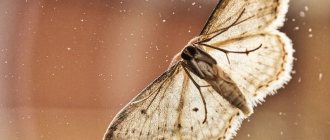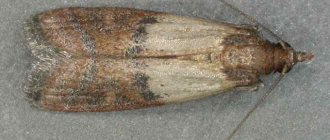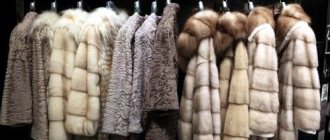How can you tell if there are moths in your house?
The eggs of the pest are very difficult to detect: their length is no more than half a centimeter, and their color is translucent. After a week, moth larvae are born from the eggs, which cause damage to the fur. They eat only the fur, leaving the skin behind. For this reason, bald spots appear. From them you can understand that the fur coat has new owners.
There are also indicators of damaged wool:
- the fur has lost its attractiveness, lumps have formed;
- “cut” fur appeared under the fur coat;
- folds have formed that were not there before;
- the presence of clipped paths;
- Adult moths move around the apartment.
If you notice one of these signs, you should take action immediately, otherwise the clothes will no longer be salvageable.
Symptoms of infection
It is difficult not to notice the signs of moth infestation of things, as they immediately catch the eye:
- A fur surface infested with insects loses its appearance and will not look attractive due to the formation of lumps.
- The paths cut by the larvae cause the formation of folds and wrinkles in the product.
- The presence of pests is indicated by fur pile sheared by caterpillars.
- The formation of characteristic “bald patches” on the surface of things is also a sign that a moth is eating a fur coat.
- Presence of winged individuals indoors.
Having discovered symptoms of moth infestation of a fur coat, it is necessary to begin treating the product and the entire wardrobe as quickly as possible.
Features of the fur moth
The fur moth is a clay-colored winged insect. Outwardly, it looks like a butterfly, but the fur lover is distinguished by the absence of a proboscis.
Moth larvae are small translucent caterpillars. They live for about 10 months and feed on keratin found in wool. The larvae also chew through any fur that gets in their way. If there are particles of dirt and sweat left on your fur coat, this will certainly attract insects.
A moth (adult) emerges from the larvae. She cannot digest food, so the fur suffers only from moth larvae. However, the moth lays a large number of eggs (about 12 eggs per hour). An adult lives for a month, during which time a whole colony of pests forms in your clothes. Therefore, when putting away a fur coat until the next winter season, it must be thoroughly cleaned.
The second life of a moth-damaged fur coat
A moth has chewed on your fur coat, are you in despair, don’t know what to do with it? There is a way out of any situation, sometimes very simple, and sometimes expensive.
Before you get upset, evaluate the scale of your losses:
- If you notice minor stains on the collar, it may be enough to simply cover the flaw with a scarf or shawl.
- A chest island will hide a brooch of a suitable size, with a distracting effect.
- If the larva has damaged inconspicuous places, you can simply shade them with paint, a marker, shoe polish, just choose the tone.
- If you need to get rid of the affected areas on your fur coat, perform a small “operation”. To do this, cut out the infected areas and try to sew the incision. But first, make sure you can do it without being noticed.
- For severely damaged clothing, you may have to get creative. For example, make leather inserts, shorten the product, change the length of the sleeves, and so on. It is quite possible to recut the fur coat.
- What remains, on the one hand, is the easiest, and on the other hand, the most expensive option, when nothing can be done - buy a new fur item from a mouton or mink.
We showed a photo of what a fur coat looks like when eaten by moths, and told us how to prevent such a nuisance. Don’t let your favorite, perhaps your only, fur coat fall into disrepair. Consider the recommendations that will help you avoid the appearance and proliferation of moths in your wardrobe.
Where do moths come from?
Sometimes fur coats in stores are sold already with moths. This is the most common reason for insects to appear in the house. Even purchasing items from expensive stores does not exclude the possibility that the clothes will not contain pest larvae. However, the insect prefers used items, so buying a used fur coat is a risky business; This kind of thing requires careful checking.
Wherever you buy your outerwear, don't immediately put it in your closet. Let it hang on a balcony or other warm or cold room for 2-3 days. Moth larvae cannot tolerate low and high temperatures, so they die in such conditions.
A fur pest can appear not only with a fur coat: be careful when purchasing carpets, furniture and woolen clothes.
In rare cases, fur moths enter the house with the dog. It does not parasitize animals, but can use them as a temporary shelter. If your pet has short hair, there is nothing to worry about: the insect only chooses dogs with long hair.
What to do if a moth has eaten a mink coat?
Many women, seeing an unpleasant “surprise” for themselves, panic, get upset, mentally throw away the damaged product and make plans to beg their husband for a new mink coat. But if you love a product very much, you don’t want to give it up. You can avoid further eating of your fur coat by moths. We offer some tips for eliminating unwanted guests.
- To begin, take your fur garment outside. Shake it well. Such manipulations will save you from existing insects. In addition to mechanical impact, temperature shock also helps. These individuals are afraid of high and low temperatures. If the moth appears in the summer, the heat and sunlight will kill the existing larvae. It also fights moths and frost in winter.
- A good addition to the previous actions would be to comb out the eaters. But since it is difficult to destroy the larvae with a regular accessory, use a fine-toothed comb. But you need to do this exclusively on something, so that you can easily destroy the pests later.
- In difficult cases, insecticidal agents are used. Today, there are various chemicals that will help cope if moths start eating fur coats. An aerosol with an insecticidal spray is used to treat the fur coat and the closet where it was located. Afterwards, the fur product is wrapped in a cover. Clothes should be sprayed periodically every 2-3 weeks.
Also read: How to get rid of poplar moth?
To prevent the appearance of moths in your wardrobe, you need to carry out prevention. Check out the video that will help you carry out all the activities correctly.
How to fight moths?
If you notice a winged fur lover, then don’t hesitate for a minute, because at stake is an expensive product that can still be saved.
Ways to control insects:
- insecticidal method (use of chemicals);
- mechanical protection;
- folk remedies.
Sometimes you need to use several methods at once. These methods are also suitable for preventing the appearance of moths. Let's look at them in more detail.
Insecticidal method
The most effective way to fight if moths eat a fur product. Therefore, you need to start with him.
Advantages of the method:
- does not harm fur;
- easy to use;
- gives quick results;
- inexpensive.
Chemicals are presented in the form:
- fumigator;
- plates;
- tablets;
- aerosol.
If moths have not ruined your fur coat, you need to treat your closet and things with aerosols every two to three weeks. Chemicals are not harmful to health, but may cause an allergic reaction when sprayed. Therefore, you should wear a respirator when using them.
The product must be sprayed on all sides and placed in a special case. When processing, do not ignore folds, pockets and lining material.
A sales consultant at a household chemicals store will help you choose which product is right for you.
Tablets and plates are also an effective method. They contain vegetable oils, so they are not harmful to humans and pets.
You can also buy special gels that come in containers. They need to be laid out or hung in the closet.
Liquid products give quick results and destroy larvae and adults.
Fumigators are recommended to be used only for prevention, because they are not designed to instantly kill insects. But they are very easy to use: the device just needs to be plugged into an outlet.
To ensure that pests are eliminated, take the item to the dry cleaner.
However, even using all of the above methods, some tenacious moth larvae may remain. To achieve maximum results, repeat the procedures several times. We advise you to sometimes do a general cleaning and treat not only the closet with the fur coat, but the entire apartment.
Mechanical protection
This method does not require additional costs. You just need to periodically shake out the fur products and ventilate them.
It is best to perform the procedure when the air temperature is 35–45 degrees Celsius. To improve results, place the fur coat on the seat of a closed car that is in direct sunlight. Leave the clothes for 5-6 hours. Then the product will heat up to the required temperature and the moth larvae will die. You can also take the item outside in severe frost.
It is recommended to combine mechanical protection with chemicals.
Folk remedies
If the moth has already eaten the fur coat, then folk remedies will be powerless. However, they will be an excellent preventive measure. The following will help repel the pest:
- Orange zest or tangerine peel. Moth larvae cannot tolerate the smell of citrus fruits. Dry the peel and put it in your pockets and in the case with the product.
- Geranium and lavender. Pack them in fabric bags and put them in a cover.
- Mint. Dry mint can be placed in the pockets of your fur coat.
- Tobacco. It needs to be scattered at the bottom of the case or cabinet.
We advise you to complete the product with all of the above, then the insect will not spoil the fur coat.
We store things correctly
Proper storage of things not only provides reliable protection from hungry parasites, but also allows the fur to maintain its noble appearance. In the winter season, fur coats, hats, and fur vests must be protected from moisture. In conditions of high humidity, the moth will reproduce safely and enjoy life. Items exposed to rain or sleet should be immediately hung on hangers, combed and dried at room temperature. You cannot use a hairdryer, gas burners or heaters.
In the summer, you should store clothes more carefully:
- First, before packing, clean your fur coat from stains. Moreover, it is better to use dry cleaning services,
- secondly, check the reliability of the buttons and the condition of the locks. Replace them if necessary,
- Next, we purchase a special cover for the fur coat. The cellophane option immediately disappears: under such material the fur coat will dry out and the fur will lose its proper appearance. The ideal option is cotton or linen. The fabric will provide the necessary breathability.
Important! Budget variants of cases that have bright colors (green, red, yellow, blue) can greatly stain the packed items. If a fur coat is dear to you and you want to maintain the presentability of its fur, do not skimp on this attribute.
- In the pockets of the fur product, as mentioned above, put orange peels, dry leaves of geranium, lavender or mint. You can also purchase special anti-parasite tablets.
Moths and their larvae, which damage fur, do not like the strong smells of citrus fruits.
- in the room where the packaged fur coat is stored, the following conditions must be observed: air temperature - 0-19 degrees Celsius, humidity - 30-50%. If it is impossible to achieve these indicators, then the product must be regularly (once every 5-6 weeks) removed from the case for ventilation and combing,
- Periodically inspect your fur product for the presence of moth larvae. The best option would be to clean the fur with a vacuum cleaner during general cleaning of the apartment,
- Place only clean items in the closet where the packed fur coat is stored.
These simple measures can preserve the “health” of your fur coat for more than one season.
See also: how to protect fur products from moths? 3 proven methods
Methods for restoring a fur coat
Even if a butterfly has eaten a fur coat, this does not mean that the clothes should be thrown away. It all depends on the degree of damage. If you took action in time and destroyed the pest, you can correct the fur coat and continue to wear it.
If the affected areas are small in size and hidden from prying eyes, then you can paint over the bald spots. To do this, you will need a felt-tip pen in the color of your fur with a thin tip.
The gap can be decorated with embroidery or a patch. In addition, combining fur products with other fabrics is now in fashion.
A brooch or stole will help hide your bald spot. But this is the case if problem areas have formed near the collar.
Another good way is to cut out the affected area. To do this, you need to carefully cut it and sew up this place. When sewing, do not tighten the thread too much, otherwise the fur will shrink and you will get an uneven seam. Before you start cutting, make sure that the seam will not be visible. If you are far from masterful with a needle, it is better to take your outerwear to a tailor.
If the insect did not leave you a chance for restoration, another option is possible. Fur coats that have been eaten by moths can be altered, for example:
- combine with other fur;
- shorten;
- turn into a vest;
- sew a fur hat.
Do not despair if a moth has eaten a mink coat or other woolen clothing, because you can always correct the situation. But from now on, be careful and take preventive measures.
Prevention and rules for storing fur coats
Before you send your furry beauty into “summer hibernation,” you need to carefully prepare. This will prevent the appearance of pests.
To do this, it is recommended to carry out the following activities:
- Be sure to clean the product after the end of the season. Existing traces of wear are removed by dry cleaning.
- Fix any problems with the fittings. Carry out cosmetic repairs if necessary.
- Take care of a protective anti-moth cover, which will prevent parasites from getting to the treat. Don't skimp on this accessory. You can purchase covers soaked in essential oils, which moths really don’t like.
- To prevent pests from touching the fur product, create favorable storage conditions, ventilate the product from time to time, and let it breathe.
What do adults eat?
Having figured out how the larva eats, the question arises of what an individual adult moth eats. Despite the widespread belief that it is harmful, the butterfly is not capable of damaging food and things, since it does not have a developed feeding apparatus.
The most significant damage occurs in egg laying. It turns out that only moth larvae eat, and adult moths contribute to the reproduction of offspring.
Underdevelopment of the proboscis and intestines at the butterfly stage reduces the lifespan of the insect to 15-30 days. An adult moth is able to feed on the reserve fat accumulated during the caterpillar stage, and at the end of it, on its own muscles, thereby shortening its lifespan.
It is because of this that at the end of life the mass of the parasite is 2 times less. If the female carries eggs, then the duration of existence does not exceed 14 days. At the same time, males are able to live up to 1 month.
The main enemy is moth larvae
Fur moth larvae.
Moth larvae eat as much as they need to store energy in order to pupate and then turn into a butterfly. And at the end of its life cycle, the butterfly will lay eggs and die.
The larvae can be found at the base of the fur hairs , where they are conveniently located in cozy small cocoons. It is extremely important, even if your favorite woolen item has already been lost, to destroy the moth, because it happily eats other natural fabrics and can even move on to upholstery, carpets and shoes.
Moth traces found
If it has already become noticeable that a moth is eating a fur coat, then immediately chemically treat the product so as not to spread the moth infestation to other areas. Follow these steps:
- Carefully examine the fur, remove matted lumps (they contain moth larvae). Apply moth repellent to the entire area of the product, then shake and hang to air;
- When a moth has eaten a fur coat in a small area in the collar or chest area, it will be appropriate to hide the unsightly spot with a large brooch, drapery, scarf or stole;
- If the fur coat has not been eaten by moths so much and from the outside it will not be so noticeable, the slightly bald areas of the outerwear can be painted over with a felt-tip pen to match the fur. At some distance, a bald spot will not give itself away;
- With skillful use of a needle, you can use this method of hiding bald spots. Using a blade, carefully cut out a piece of leather in the moth-stricken area and stitch down the edges. Such a seam will not be noticeable under the fur at all if it is done correctly and the fur coat does not lose its charm;
- The most radical way to revive a fur product is to alter it in a new way, removing damaged areas and replacing it with other materials. You can, for example, create a new short fur coat using two types of fur, or combine it with knitted or guipure fabric inserts, as in the photo.
Life cycle features
Moths in fur coats appear in the summer when the product is hidden in a closet for storage. In winter, the insect can also be in the house, but due to the fact that the fur product is often worn and periodically “walked” in the cold, the larvae die from the low temperature. In summer, all conditions are created for the normal existence of the insect.
On a note!
For fur coat moths, little is required - no direct sunlight, a temperature of at least +10 degrees Celsius, moderate humidity, and a fur coat in the closet.
Most often, moths enter an apartment or house through open windows in the evening. The butterfly becomes active at night and quickly flies towards the light. Once in a person’s house, he looks around and determines by smell the presence of a fur coat or other fur products in the closet.
The butterfly itself does not feed on anything and lives for about 14 days. But during this time it lays about a hundred eggs. The larvae are born within a few days and develop for about a month. All this time they are actively sharpening their fur coat. In a month, even one caterpillar causes significant damage. If there are several caterpillars, by the beginning of winter the fur coat will become unwearable.
If it's already started
When a product is infested with moth parasites, this is clearly visible in the bald areas of the fur. However, there are less noticeable signs that should be identified in time to prevent damage to the entire fur:
- The fur coat begins to crumble slightly, lint accumulates at the bottom of the closet;
- On the affected area, the pile is directed in different directions, while all the fur lies in one direction;
- Crumpled fur in the path of larvae movement.
Potent insecticide aerosols will give excellent results in the fight against moths. Moth repellents for fur coats that will quickly and effectively help kill insects:
- Extramit;
- Antimol;
- Raptor;
- Clean house;
- Armol.
These preparations are sprayed over the entire surface, as shown in the video. In a well-ventilated area, lay the fur coat horizontally, treat it both outside and inside (from the lining side), including the pockets. After this manipulation, place the product in a case, also pre-treated with spray. Leave the mink coat in this position for a week, and then thoroughly ventilate it in the fresh air.
How to bring it into proper shape
When all measures to get rid of parasites have been taken, all that remains is to mask the flaws resulting from damage to the fur by moths in the following ways:
- Narrow bald spots can be easily painted with a felt-tip pen to match the fur;
- Have your entire fur coat repainted at the dry cleaners to match your skin color;
- If there are bald spots only at the bottom of the product, then you can cut off the hem, thus creating a short fur coat or sheepskin coat, and the item itself will be preserved;
- When the defects are in the area of the collar and shoulders, it is easily draped with a shawl, scarf or hidden under a huge brooch.
This article describes in detail recommendations on how to preserve a fur coat from moths. By using them for preventive purposes, your favorite mink coat will remain safe and sound for a long time. When a moth has done a little work on a fur item, certain actions will also help return it to its previous appearance.
Effective means
There are many chemicals and folk methods on how to preserve mink fur and get rid of moths.
Case
You can use the raptor case. The sealed clasp will protect against pests getting inside. In this case, insects that get inside die. The special composition does not harm objects and does not impregnate them with foreign odors. Similar raptor products can be seen in the photo.
Aerosol
Do not spray the product directly onto the surface. This can ruin the fur. In this case, the entire cabinet is treated against moths. One can will be required for the entire season. The procedure is carried out twice a month.
Since the products contain insecticidal components that are harmful to humans, a mask, respirator and gloves are worn.
Children and animals should be removed from the room, as fumes can cause poisoning. After processing, the cabinets are tightly closed.
Such drugs as raptor, aerosol raid, extra mit are distinguished by their effectiveness.
Pills
Such products are produced in special boxes. They are highly concentrated and the smell remains for a long time. The effect of the drug lasts for several months.
The tablet not only destroys moths, but also prevents them from multiplying in the closet and protects against the appearance of eggs. Sections also work. The records are hung inside the furniture, as can be seen in the photo.
Optimal conditions
Those who decide to protect their fur coat from damage in the warm season in an ordinary closet should know how to properly care for the product and properly store a mink fur coat. The main conditions are described in the table.
Table - Requirements for storing mink fur coats
| Condition | Primary requirements |
| Space | — Post freely; - choose wide hangers; - purchase a fabric cover |
| Lighting | — Avoid direct sunlight |
| Temperature | — Ensure the indicator is not higher than 15°C |
| Moth protection | — Use sachets, sprays |
| Removing accessories | - Break off decorations; - remove the belt from the belt loops; - remove change from pockets |
Space and removal of accessories
First of all, you need to free up space in your storage closet.
It is important that the fur coat is not squeezed or wrinkled by neighboring items. The product should be placed on wide, durable hangers, the size of which corresponds to the size of the clothing.
The product must be fastened with all available hooks and buttons to avoid deformation.
It is best to store a mink coat in the case that comes with it upon purchase. In addition, you can purchase special covers in fur stores or regular hardware stores. The beauty of the cover is not only that it will protect the fur from mechanical damage, but also that it will protect the fur coat from moths.
Before hanging mink clothes in a case, you should remove brooches, jewelry, belts, and remove all things from your pockets. This is done so that the fur does not deform and the base does not stretch.
You cannot place a fur coat in polyethylene, since the fur will not be able to “breathe” in it. If a special cover is not available, it is better to make it from cotton fabric and attach a moth sachet inside.
Lighting and temperature
Since fur is afraid of sunlight, the place where it is stored should be dark but well ventilated. If summer hibernation occurs in a closet, its doors should be left open regularly to allow fresh air to flow into the fur.
Mink coats love the cold: the optimal temperature for them is from 5 to 15°C. It is almost impossible to achieve such conditions at home, so as an alternative, you can set the air conditioner in the dressing room to the minimum temperature or regularly take the fur coat out to the balcony for ventilation. To prevent the sun's rays from falling on the fur, the product should not be taken out of the case when airing.
Moth protection
Keeping fur away from the sun and creases is just as important as keeping a mink coat away from moths. Today there is a huge variety of substances on sale that repel butterflies and caterpillars of these insects.
Buy aerosols or sachets. But you can make anti-moth bags with your own hands by placing dry tangerine peels inside. According to reviews, you can replace citrus fruits with bergamot or lavender.
It is very important that there is no naphthalene, chemicals or their breakdown products left in the closet - this can irreversibly damage the fur. Interestingly, cedar negatively affects the condition of a mink coat, so it is important that the cabinet for storing it is not made of such wood
Knowing how to properly store a mink coat, you can wear it for more than one year. Following important but simple rules will give you the opportunity to enjoy fur clothing for ten seasons or even more.
Stages of pest development
Insect development occurs in several stages:
eggs in a dark, secluded place, for example, in a closet .
From them appear moth caterpillars , which by the time their presence is noticeable, will make a bald spot in the fur coat.
The caterpillar, when it has eaten enough and finds a secluded place, will turn into a pupa, and butterfly .
Moths in a city apartment can reproduce all year round. The normal life cycle of the pest lasts no more than 90 days.
Preventive actions
There are simple rules on how to protect a fur coat from moths.
- After the cold weather is over, you should take the product to the dry cleaner to eliminate the smell of sweat.
- Clean out the closet. Remove all items and wash the cabinet with water and vinegar or lavender essential oil. Clothes that will not be worn until cold weather need to be washed, dried, and packaged in plastic bags. Fold the clothes. Lastly, hang up the fur coat.
- The fur product must also be packed in a plastic bag. There are special cases for storing fur coats on sale.
- If moths or moth larvae are found in the closet while cleaning, you should use insecticides. Treat the moths, then proceed with wet cleaning.
- You should periodically leave the cabinet door open for ventilation.
- It is recommended to take the fur coat outside into the scorching sun at least twice during the storage season.
- Before placing the fur coat in the cover, you can initially spray it from the inside with an insecticidal agent. Air it so that the smell disappears, then put it on a fur product.
Moths will not start in a fur coat if all these conditions are met, but it is not always possible to take into account all the nuances. What to do if a moth has eaten a fur coat, or is just starting to do this; there are also effective methods.
Folk remedies for potato moth
There are a number of popular techniques that will help reduce the number of pests in the garden. For example, caterpillars will not feed on tubers if a little ash is thrown into the holes when planting. There are also recipes for spraying plants during the summer (2-3 times per season):
- Combine a glass of wormwood herb and the same amount of ash, pour 3 liters of boiling water, leave for 2 hours.
- Mix 100 g of grated laundry soap, 200 g of wormwood and 50 g of onion peels. Brew 5 liters of boiling water and leave for 3 hours.
- Boil a kilogram of celandine stems for 10 minutes in 5 liters of water, let cool. Dilute the product with 5 liters of water before use.
